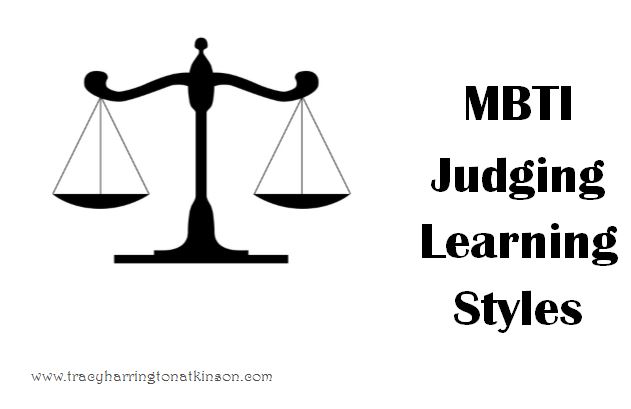Judging Learning Style
What are the behaviors others tend to see? Do you prefer a more structured and decided lifestyle (Judging)? This preference may also be thought of as your orientation to the outer world.
~Excerpted from www.myersbriggs.org
_______________________________________________
Frequency
Judging (J) 54.1% of the total population
Perceiving (P) 45.9% of the total population
_______________________________________________
The estimated frequency table was compiled from a variety of MBTI® results from 1972 through 2002, including data banks at the Center for Applications of Psychological Type; CPP, Inc; and Stanford Research Institute (SRI).
Learner Keyword: Overachieving Learner
Learner Question
Judgers, while learning, address the question, “How does this create order in my life?”
Learning Style
Judgers (J) focus on rules and order above all else. They are decisive, self-regimented and planners, being task-oriented. They need the essentials. They create intricate, steady study plans, structuring study to avoid any emergencies. One assignment will be completed prior to another one starting.
Deadlines are sacred to Judgers. They will not be late. They are quick to take action, especially when a deadline is expected. They prefer to make a decision and move on.
Judgers answer questions based on their current knowledge but cannot tolerate loose ends and unanswered questions in their learning process
Cognitive Environment
Judgers need order, control and rules. Objectives and rubrics are essential to their learning process. They like detailed instructions
Their environment needs to be structured, learning toward more traditional teaching techniques. They can participate effectively in a group atmosphere but need guidelines, efficiency and order.
Judgers are most comfortable:
- Knowing the expectations required of their work
- Structure
- Order
- Prefer independent work and studying
- Group work not disliked but not needed to enhance learning experiences
- Creating plans
Judgers are least comfortable:
- Surprises
- Not planning
- Having an educator who seems disorganized
- Inefficient group work
- Not understanding expectations and objectives
- Slow moving classrooms with no plans
Learn More:
For more information on teacher and classroom tips, learner tips, instructional strategies and assessment strategies, see MBTI Learning Styles: A Practical Approach or learn more on Udemy.
Click on one of the sixteen personality types for more information:
Click on one of these dimension for more information:

For other learning styles: MBTI Learning Styles – A Practical Approach Available in paperback; Kindle; and pdf versions
For other learning styles: MBTI Learning Styles – A Practical Approach Available in paperback; Kindle; and pdf versions
References
Bonwell, C. & Eison, J. (1991). Active Learning: Creating Excitement in the Classroom. ERIC Digest. ERIC Clearinghouse on Higher Education, Washington, D.C
Career Assessment. (2017). The 16 Myers-Briggs Type Indicator Personality Types (MBTI personality types). Retrieved from: http://careerassessmentsite.com/tests/myers-briggs-tests/about-the-myers-briggs-type-indicator/the-16-myers-briggs-personality-types/
CPP, Inc. (2017). Linking MBTI® Personality Type to Learning Style – Strategies and Insights. Retrieved from: http://www.cppblogcentral.com/cpp-connect/linking-mbti-personality-type-to-learning-style-strategies-and-insights/
Defiance College. (2106). What’s Your Personality Type? Retrieved from: http://library.defiance.edu/learningstyles/myersbriggs
Gregory, G. (2008). Differentiated instructional strategies in practice: training, implementation, and supervision (2nd ed.). Thousand Oaks, CA: Corwin Press. p. 97-99.
Humanmetrics. (2017). Learning Styles. Retrieved from: http://www.humanmetrics.com/personality/learning-styles
Kiser, H. (2017). Choice board. Retrieved from: https://hillarykiser.blogspot.com/2012/10/choice-board.html?showComment=1491939410939#c9063789945839625994
Krafka, K. (2017) Learning Menus. Retrieved from: http://prescriptionforgiftedsuccess.weebly.com/learning-menus.html
Litemind. (2017). What is mind mapping? Retrieved from: https://litemind.com/what-is-mind-mapping/
Martinez, M. (2006). What is metacognition. Phi Delta Kappan, 64(10), 696-699.
Melvin, J. (2017). Personality Type as an Indicator of Learning Style. University of Rochester. Retrieved from: file:///C:/Users/Tracy/Downloads/JMelvinSGf13paper%20(2).pdf
Myers & Briggs Foundation. (2017). How frequent is my type? Retrieved from: http://www.myersbriggs.org/my-mbti-personality-type/my-mbti-results/how-frequent-is-my-type.htm
Myers & Briggs Foundation. (2017). Type and Learning. Retrieved from: http://www.myersbriggs.org/type-use-for-everyday-life/type-and-learning/
Myers, I. (1998). Introduction to Type: A Guide to Understanding Your Results on the MBTI Instrument. Consulting Psychologists Press.
Myers, I., McCaulley, M., Quenk, N. & Hammer, A. (2009). MBTI Manual: A Guide to the Development and Use of the Myers-Briggs Type Indicator Instrument. Consulting Psychologists Press.
Okoro, C. & Chukwudi, E. K. (2011). Metacognitive skills: A viable tool for self-directed learning. Journal of Educational and Social Research, 1(4), 71-76.
Pelley, J.W. (2008). The Success Types Learning Style Type Indicator. Retrieved from: Texas Tech University. https://www.ttuhsc.edu/som/success/lsti.aspx
Smith, C. V. & Cardaciotto, L. (2011). Is active learning like broccoli? Student perceptions of active learning in large lecture classes. Journal of the Scholarship of Teaching and Learning, 11(1), 53-61.
University of Texas. (2017). Experiential Learning. Retrieved from: https://facultyinnovate.utexas.edu/teaching/strategies/overview/experiential-learning
Western Nevada College. (2017). Personality Types and Learning. Retrieved from: http://www.wnc.edu/mbti/personality-types/
Tracy Atkinson is certified in Myers Briggs Type Indicator (MBTI) by CPP, Inc. The findings on learning styles derive from research, experience and observations.
Tracy Atkinson, a mother of six, lives in the Midwest with her husband and spirited dachshunds. She is a teacher, having taught elementary school to higher education, holding degrees in elementary education and a master’s in higher education. Her passions include researching, studying and investigating the attributes of self-directed learners. She has published several titles, including: The Art of Learning Journals, Calais: The Annals of the Hidden, Rachel’s 8 and Securing Your Tent. She is currently exploring the attributes of self-directed learners: The Five Characteristics of Self-Directed Learners.

Comments are closed